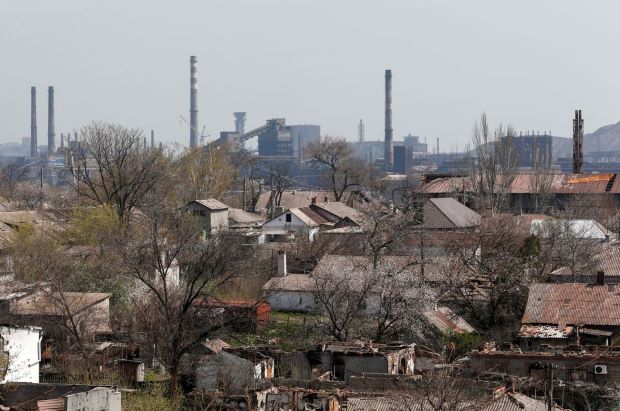2,000 civilians are holed up with Ukrainian troops in a steel plant in Mariupol, officials say
By Cora Engelbrecht
KYIV – Intense fighting continued around a large steel factory in the southern city of Mariupol, in what appeared to be one of the last redoubts of Ukrainian forces in the besieged city, an adviser to the mayor said Monday (18).
Pyotr Andryushchenko, an aide to Mayor Vadym Boychenko, said that some 2,000 civilians were trapped along with the soldiers inside the Azovstal steel plant, one of Europe’s largest metal factories.
Andryushchenko insisted that street fighting was continuing throughout Levoberezhny, the district that includes the factory.
The Russian Defence Ministry said Sunday (17) that its forces had surrounded the steel plant, and that the Ukrainian forces holding out “forbade negotiations about surrendering”, citing an intercepted radio transmission. The ministry repeated a demand that the Ukrainians put down their weapons. “In case of further resistance,” the ministry said, “all of them will be eliminated.”
“In reality it is not surrounded,” Andryushchenko said Monday. “For the past few days our troops have been engaged in intense street fighting throughout Levoberezhny.” He said the majority of the fighting was taking place along a main road, called Tahanrozka that led from the plant to the outskirts of the city.
He described the steel plant as a “fortress”, but would not disclose how many troops were inside. And he denied reports that the factory held the last concentration of Ukrainian forces, claiming troops were still holed up at a pair of factories, Azovmash and Illich, elsewhere in the city.
Andryushchenko and other officials left Mariupol weeks ago, and his statements could not be verified. Communication with people still in the city is limited, making it impossible to get a clear picture.
Taking Mariupol, a port city in southern Ukraine, is critical to Russian designs to form an unbroken land corridor stretching from the Donbas region bordering Russia to the Crimean Peninsula.
Analysts at the Institute for the Study of War, a Washington think tank, said Russian forces would likely use “overwhelming firepower” to try to force the holdouts at the Azovstal factory to capitulate in the coming week. But the institute predicted in its latest assessment that the final battle with the Ukrainian defenders, who “appear intent on staging a final stand,” could cost Russia dearly.
The presence of civilians in the plant, which was confirmed by the chief of the Mariupol patrol police, Mykhailo Vershynin, raised concerns about a potential humanitarian calamity stemming from both fighting and hunger.
“There was not a lot of food inside the plant to begin with because it was for our troops,” Andryushchenko said. “But now they are needing to feed 2,000 people.”
Many of the civilians who have gathered there arrived after their homes were destroyed by shelling or they were evicted by Russian forces, he said, and have sheltered with troops in a network of tunnels beneath the plant.
“These people, many wanted to avoid being displaced or deported, so they found protection with our troops, in the basement of the plant,” Andryushchenko said.
The Ukrainian army had arranged two operations over the past two weeks to bring food to the plant, he said. But the situation will likely grow more dire as Russian troops have blocked anyone from entering or leaving the city.
As fighting intensifies, Ukrainian officials have warned that Russian forces may turn to chemical weapons to flush the holdouts from the tunnel network under the factory.
In anticipation of possible atrocities, President Volodymyr Zelenskyy of Ukraine accused Russia of “deliberately trying to destroy everyone” at the plant. He said he would refuse further peace talks with Moscow if its forces committed more atrocities.
Andryushchenko raised disturbing reports that Russian forces were using Ukrainian civilians as human shields, putting them at risk of being killed.
Outside the plant, Russian soldiers were leading civilians to the front line, he said, forcing them to register for “mobile passes” at an office close to the line of fighting, about 3 miles from the steel plant.
The office had been installed last week by Konstantin Ivashchenko, who was recently named the “new mayor” of Mariupol by the Kremlin-backed separatist government calling itself the Donetsk People’s Republic. The passes, the existence of which has also been reported by Mariupol’s police, are required for residents to walk outside.
“Some are walking long distances to the office, up to 10 miles, and then they are waiting in long lines,” Andryushchenko said. The civilians are required to wear white bands on their arms and legs. Russian soldiers typically wear such bands, he said, raising the possibility that they are intentionally endangering the Ukrainian civilians.
-New York Times


